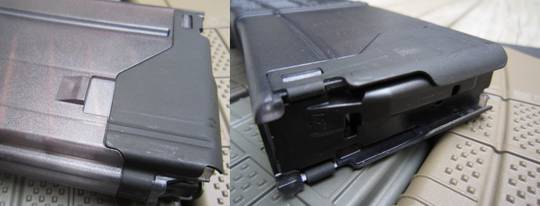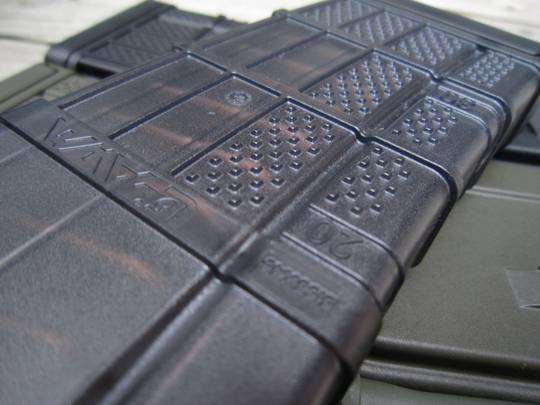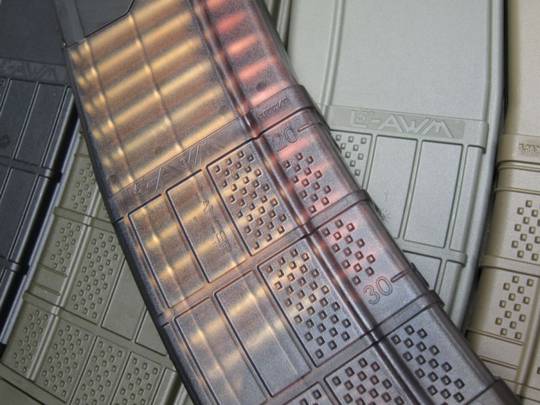[ Nathan is an avid shooter and a rising senior at Penn State studying Security and Risk Analysis. ]
A few months ago, Lancer Systems announced an improvement to their L5 magazine, which improved on the polymer magazine design by replacing the polymer feed lips, which could easily bend and break under pressure, with a set of steel feed lips molded into the polymer magazine body. Now Lancer has improved on that design with the L5 Advanced Warfighter Magazine. Lancer was kind enough to send TFB a sampling of their wares, a color sampler of their 30 round AWMs and a 20 round AWM, which I am looking forward to testing in the Mossberg MVP.
Starting from the top, the first change noted was the one piece, full steel feed lip design. In contrast to the two piece lips of the L5 that didn’t extend past the lip area themselves, the lip on the AWM extends from front to back, from the top of the lips, down to the top of the mag latch area, which allows the magazine to sit on the catch with metal to metal contact, instead of the metal of the mag catch possibly gouging the polymer magazine body and causing feed issues.
Moving down the magazine body, we reach the point where the body ceases to be smooth. There is a small, but thick reinforcing rib circumnavigating the magazine, giving it more strength. This rib is low enough that it will not interfere with any STANAG compliant magazine well, such as the AR-15/M16, as well as lower wells, including the L85A1, HK 416, SCAR, and ARX 160. This area also enjoys another feature new to the AWM, an aggressive grip texture between the reinforcing ribs, allowing for more positive control on the magazines when manipulating them. Personally, I appreciate the addition of this, as I painstakingly cut skater grip tape to fit in the recesses of PMAG reinforcing ribs for a better grip.
At the bottom of the mag, the newly redesigned floorplate is encountered. The new follower wraps around the bottom, and is held in place by a lock plate under tension from the follower spring, taking a page from Magpul’s PMAG floorplate design. This removes the smaller tabs that need to be bent to remove the plate, as well as removing the need for a tool to disassemble the magazine, unlike the L5, for which lancer sells a floorplate removal tool. The floorplate is also slimmer than Magpul’s offering, maintaining a slimmer outer profile, and making it easier to use in double mag pouches.
Disassembly is a breeze, using only a single round of ammo (or other skinny object) to depress the locking plate, and sliding the floorplate to the rear, off the magazine body. After slowly relaxing the follower spring, the follower, spring, and lock plate can be pulled from the mag body with ease. The first thing I noticed is that the follower spring is much beefier than others, ostensibly to provide a faster presentation of ammo to the top of the magazine for faster cycling weapons, such as short barreled, somewhat over-gassed carbines. The additional force provided could spark worries in other polymer magazines, but the hardened steel lips of the AWM are more than up to the challenge. The other thing about the follower assembly that was quickly noted was the svelteness of the follower compared to other non-tilt designs. The AWM’s follower was nearly half as tall as the PMAG, and it still does its job admirably, without a single trace of follower tilt.
Available as an option, the translucent AWMs allow the shooter to identify the number of rounds remaining in the magazine quickly, with index marks showing 30 and 20 rounds remaining. Below about 18 rounds remaining, the rounds are nestled inside the magwell and hidden from view. This is one place that I prefer Magpul’s version better, with a bright follower coil to indicate number of rounds after they are not visible. However, the fully translucent body gets the badassery vote from me, as it looks great and functions well.
The AWM by itself is nice, but cripplingly useless except as a bludgeon if it doesn’t have a weapon to fit into. It inserts cleanly and effortlessly into the magazine well of my AR, drops free without the slightest hesitation when the mag catch is pressed, and seats easily on a closed bolt, even with a full 30 round load.
Now we turn quickly to the 30 round L5AWM’s little brother, the 20 round AWM, which maintains 100% of the design features of its larger brethren. Since it maintains the same constant curve internally as the 30, it is able to use the no-tilt follower, unlike the straight bodied PMAG 20, with which I have had issues keeping their ‘controlled tilt’ follower system from tilting too much and jamming my rifle.
Overall, the L5AWM by Lancer Systems is an excellent upgrade to their L5 translucent magazine. With what seems to be a renewed focus on durability and ease of use, Lancer has scored a resounding victory in the polymer magazine market. Expect a follow up article in the coming months with a first-hand report on the reliability of these new magazines.
*P.S. *If anyone from Lancer is reading this, I would love to see a release of a similar treatment to the AWM as they did to the L5 with the L5Competition 48 round magazines. L5 Advanced Competition Magazine maybe?
Quick Edit: I just received word that Lancer is planning a 10 and 48 round AWM for 2012.
 Your Privacy Choices
Your Privacy Choices








